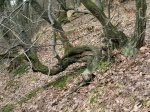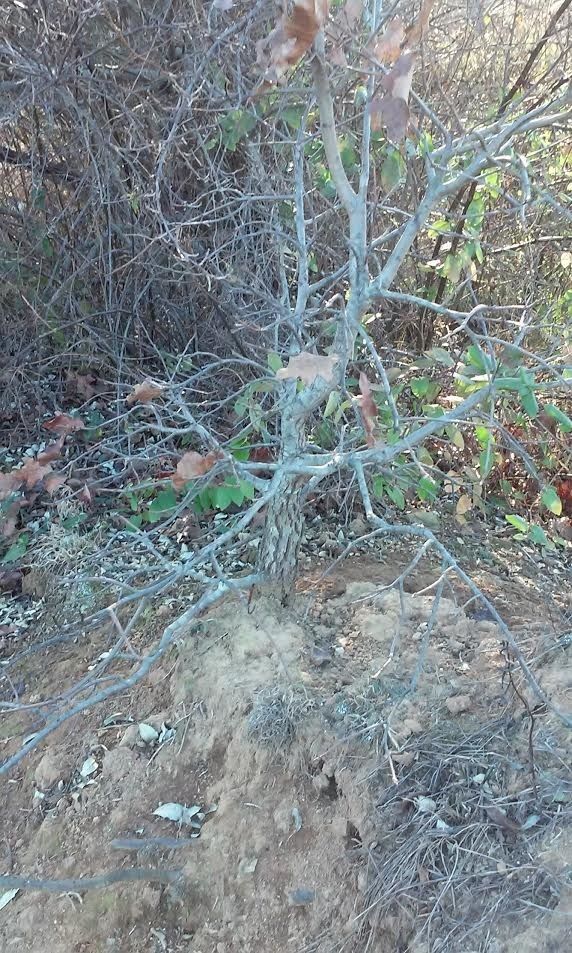oak in the wild
+8
Vlad
BrendanR
M. Frary
JimLewis
steveb
Kevin S - Wisco Bonsai
Leo Schordje
curts83
12 posters
Page 1 of 2
Page 1 of 2 • 1, 2 
 oak in the wild
oak in the wild
I live in ohio and I was out deer hunting today. I came across an oak tree and was shocked because it was only two feet tall and has a three inch trunk. What are my odds of actually digging this tree and it surviving. I know the tap roots on these things are massive. The tree has excellent movement I would really like to try and harvest it.
curts83- Member
 Re: oak in the wild
Re: oak in the wild
There is no way to answer this question. A photo would help, but even then, at best you'd get a guess. So odds are 50:50, maybe it will, maybe it won't.
Generally, most who collect wild trees will tell you that they have very poor luck with oaks. But poor results is not absolutely impossible. Occasionally one will survive more than 2 years.
Oaks are known to have long deep tap roots. If the soil where it is at is deep, that would likely be the case. With a deep tap root, it is unlikely there would be enough fine roots near the trunk to allow collecting. But if it is growing in a shallow layer of duff, on a rock surface, it might be easy to collect. So with no further info, I couldn't say. If you are lucky enough to find fine feeder roots near the trunk, there is a chance the tree will make it.
Oaks are also know to have mycorrhizal fungal associations. They may not absolutely depend on mycorrhizae, and can live without them, but they often are associated with mycorrhizae. This can make collection easier in cases where you are able to keep the mycorrhizae alive, the mycorrhizae can substitute for fine feeder roots until the tree can make its own fine roots. But the mycorrhizae are difficult to transplant, if your new soil is not compatible with the mycorrhizae it will die off leaving you with a tree with no way to pull in moisture.
End result of my ramblings is that collecting an oak successfully is a low probability event. Everything has to go just right. It is not totally impossible, just much more likely to fail than succeed.
You won't know unless you try. Read up on the best time of year to re-pot your species of oak in bonsai culture, and then go collect your tree during that time period. Good luck.
Generally, most who collect wild trees will tell you that they have very poor luck with oaks. But poor results is not absolutely impossible. Occasionally one will survive more than 2 years.
Oaks are known to have long deep tap roots. If the soil where it is at is deep, that would likely be the case. With a deep tap root, it is unlikely there would be enough fine roots near the trunk to allow collecting. But if it is growing in a shallow layer of duff, on a rock surface, it might be easy to collect. So with no further info, I couldn't say. If you are lucky enough to find fine feeder roots near the trunk, there is a chance the tree will make it.
Oaks are also know to have mycorrhizal fungal associations. They may not absolutely depend on mycorrhizae, and can live without them, but they often are associated with mycorrhizae. This can make collection easier in cases where you are able to keep the mycorrhizae alive, the mycorrhizae can substitute for fine feeder roots until the tree can make its own fine roots. But the mycorrhizae are difficult to transplant, if your new soil is not compatible with the mycorrhizae it will die off leaving you with a tree with no way to pull in moisture.
End result of my ramblings is that collecting an oak successfully is a low probability event. Everything has to go just right. It is not totally impossible, just much more likely to fail than succeed.
You won't know unless you try. Read up on the best time of year to re-pot your species of oak in bonsai culture, and then go collect your tree during that time period. Good luck.

Leo Schordje- Member
 Re: oak in the wild
Re: oak in the wild
Leo Schordje wrote:odds are 50:50, more likely to fail than succeed.
er... um... the new math ?
just razzing ya leo... as with real life convos, we sometimes amend what we began saying even as we are saying it...
as an aside, curt... you can buy mycorrhizae in a powder form from most garden supply stores for cheap (couplafewfive bucks)...
if you end up going for it, sprinkle some in your soil and it just might get you to leo's 50-50 guestimate

Kevin S - Wisco Bonsai- Member
 Re: oak in the wild
Re: oak in the wild
Thanks for the reply. Next time I'm out there I will try to take a picture and post it. The tree is also only a couple inches away from another one so It might make it even more difficult.
curts83- Member
 Re: oak in the wild
Re: oak in the wild
I collected an American Beech (with permit of course) about 3 years ago during the spring. It was 8 feet tall with a 3 inch trunk. I cut the tap root and collected a ball of fine feeder roots about 2 feet in diameter. I nearly broke my back hauling the thing back to the car. It has been chopped and is growing nicely despite other problems with ramifications and leaf size. I mention this because beech and oaks are in the same family of trees - Fagaceae.

steveb- Member
 Re: oak in the wild
Re: oak in the wild
There's a very interesting article on Harry Harrington's Bonsai4Me website regarding Oak collection that may help guide your thoughts.....
Unfortunately I don't have sufficient experience with Oaks to comment with any degree of certainty myself on the best approach. I have had some success with air layering at ground level with other species where digging is an impossibility however.
Also - If the deer are responsible for chewing the Oak into a bonsai it may be best to not shoot them. They can't help tasting nice but we need to put Bonsai first!
JT - MKBonsai
Unfortunately I don't have sufficient experience with Oaks to comment with any degree of certainty myself on the best approach. I have had some success with air layering at ground level with other species where digging is an impossibility however.
Also - If the deer are responsible for chewing the Oak into a bonsai it may be best to not shoot them. They can't help tasting nice but we need to put Bonsai first!
JT - MKBonsai

MKBonsai- Member
 Re: oak in the wild
Re: oak in the wild
Thanks jt, I'll definitely look into the article. Yes you are right the deer are responsible for chewing this oak down over the years. As for the not hunting them part I'm not sure I can do that.
curts83- Member
 Re: oak in the wild
Re: oak in the wild
The best was to try a collection on a doubtful tree -- which is the hallmark of the oak -- is to do it over a period of 2 or 3 years. Dig a deep tench around it at about the edge of the canopy. I mean DEEP, cutting the surface roots. Fill the ditch with compost or potting soil. A year later, go beneath the tree and cut the taproot with a SHARP implement. Try pulling the tree next year (or this year if you are impatient).

JimLewis- Member
 Re: oak in the wild
Re: oak in the wild
Jim, if I tried it your way could I dig the trench now and wait till next fall to cut the tap root or should I just wait until spring to do anything.
curts83- Member
 Re: oak in the wild
Re: oak in the wild
Wait until spring to do anything. Actually if you try trenching or collecting it next spring do it as the buds start to swell. If you collect it keep the native soil around the roots without disturbing them as much as possible. Plant it in a grow box or large bucket or colander with the native soil. Since these trees are hard to collect(what kind is it? Red,white or pin?) it probably isn't a good idea to bareroot it like most decidious trees.curts83 wrote:Jim, if I tried it your way could I dig the trench now and wait till next fall to cut the tap root or should I just wait until spring to do anything.
I don't collect oaks here. Just white oak and red oak here. They are coarse,grow slow and don't take to collection very well.
M. Frary- Member
 Re: oak in the wild
Re: oak in the wild
I have collected quite a few oaks successfully in southern England.
I do not find that the late summer timing of the bonsai4me website is any sort of a guarantee, and I am a bit more conservative.
First, this is a project over a few years.
Oaks have a massive tap root that goes straight down as long as the tree above. In winter I would go out and dig a single hole as small as possible to access the tap root and any other roots and sever these as close to the surface as possible. Maybe a depth of 3 - 5 inches depending on the roots above.
You need to avoid disturbing any surface roots, and you simply tunnel in from one side . If the ground is flat you may need to dig down about 2 feet from the tree to make a hole from where you can do a side shaft to aim towards the tree.
Cut all the thick roots as cleanly as you can. Then repack the hole with as much soil as you can get in there. Then leave it alone for a full year. In the summer it will be growing well, and you can just observe it and maybe treat it for fungus etc if needed but no trimming etc as it will need all its leaves to create much strength and grow many new roots to compensate for the root chop.
In the second winter you should trench it. I would dig down to a level where there are obviously no more oak roots that need to be severed. I'd expect this to be quite shallow - no more than a foot if that. Fill in the trench carefully and leave it for another year.
In thee spring of the third year you can lift it - before buds break. You need to get the whole root ball. I find that the root ball comes out quite easily if the trenching was thorough and I got all the deep anchoring roots. Then plant it as with any collected material. I use molar clay all around where the root ball is uneven. I do not remove any of the rootball at this stage, apart from neatly cutting any obviously rough anr broken roots that are sticking out. Then wait for spring and keep fingers crossed. It should come back. Leave it in that pot for 2 seasons, but from the second year you can begin wiring and minor corrections. I would not touch it in year one.
After year 2 you should be able to get it into a smaller pot by gently removing some of the rootball. I keep the soil and mix it with molar clay. Don't bare root it - certain death.
From there it is safely established as a starter bonsai and suddenly it goes from being delicate and susceptible to sudden death to becoming quite a tough species that you can actually work with quite aggressively. At this stage I tend to undertake 2 major trimming sessions in a season to get the ramification underway and to reduce leaf size.
I appreciate that 2 - 3 years just to get a tree out of the ground is a long time.#
If you are impatient or there's a reason you have to lift it then your best bet is a spring lift while it is dormant - get as much of the rootball as possible. It will need a very big pot for a couple of years. I would really not try lifting it until it has become properly dormant, as the sap flow right now is down into the roots and it will bleed out if you cut it underground. The sap is carrying the nutrients into the roots for the next year's buds, and you want as much of that to get in there as possible, especially as you are cutting away some roots. So leave it until deeper into the dormant cycle if you can. I have never lifted a tree at this time of the year and probably would not do it, unless the tree was going to be destroyed if it stayed in place - like on a building site.
I have lifted trees in early spring (2 trees over 3 years 100% success) early summer (2 trees over 2 years 50%) and late summer (2 trees that i started last year and lifted this year too early to tell but looks OK).
Good luck.
I do not find that the late summer timing of the bonsai4me website is any sort of a guarantee, and I am a bit more conservative.
First, this is a project over a few years.
Oaks have a massive tap root that goes straight down as long as the tree above. In winter I would go out and dig a single hole as small as possible to access the tap root and any other roots and sever these as close to the surface as possible. Maybe a depth of 3 - 5 inches depending on the roots above.
You need to avoid disturbing any surface roots, and you simply tunnel in from one side . If the ground is flat you may need to dig down about 2 feet from the tree to make a hole from where you can do a side shaft to aim towards the tree.
Cut all the thick roots as cleanly as you can. Then repack the hole with as much soil as you can get in there. Then leave it alone for a full year. In the summer it will be growing well, and you can just observe it and maybe treat it for fungus etc if needed but no trimming etc as it will need all its leaves to create much strength and grow many new roots to compensate for the root chop.
In the second winter you should trench it. I would dig down to a level where there are obviously no more oak roots that need to be severed. I'd expect this to be quite shallow - no more than a foot if that. Fill in the trench carefully and leave it for another year.
In thee spring of the third year you can lift it - before buds break. You need to get the whole root ball. I find that the root ball comes out quite easily if the trenching was thorough and I got all the deep anchoring roots. Then plant it as with any collected material. I use molar clay all around where the root ball is uneven. I do not remove any of the rootball at this stage, apart from neatly cutting any obviously rough anr broken roots that are sticking out. Then wait for spring and keep fingers crossed. It should come back. Leave it in that pot for 2 seasons, but from the second year you can begin wiring and minor corrections. I would not touch it in year one.
After year 2 you should be able to get it into a smaller pot by gently removing some of the rootball. I keep the soil and mix it with molar clay. Don't bare root it - certain death.
From there it is safely established as a starter bonsai and suddenly it goes from being delicate and susceptible to sudden death to becoming quite a tough species that you can actually work with quite aggressively. At this stage I tend to undertake 2 major trimming sessions in a season to get the ramification underway and to reduce leaf size.
I appreciate that 2 - 3 years just to get a tree out of the ground is a long time.#
If you are impatient or there's a reason you have to lift it then your best bet is a spring lift while it is dormant - get as much of the rootball as possible. It will need a very big pot for a couple of years. I would really not try lifting it until it has become properly dormant, as the sap flow right now is down into the roots and it will bleed out if you cut it underground. The sap is carrying the nutrients into the roots for the next year's buds, and you want as much of that to get in there as possible, especially as you are cutting away some roots. So leave it until deeper into the dormant cycle if you can. I have never lifted a tree at this time of the year and probably would not do it, unless the tree was going to be destroyed if it stayed in place - like on a building site.
I have lifted trees in early spring (2 trees over 3 years 100% success) early summer (2 trees over 2 years 50%) and late summer (2 trees that i started last year and lifted this year too early to tell but looks OK).
Good luck.
BrendanR- Member
 Re: oak in the wild
Re: oak in the wild
Could you please help me to understand the impact of cutting the taproots on the health of the plant? I am not an expert on a plant physiology but I think that the taproots have several functions the main ones: anchor and the second one - water supply. We have very hot and dry weather in Central Europe this year. Most of the trees have dropped a number of leaves in mid summer just to cope with it. What about a tree without taproots?

Vlad- Member
 Re: oak in the wild
Re: oak in the wild
I am trying to upload a photo.....but am having difficulty doing that....is there a trick to uploading to this site????
curts83- Member
 Re: oak in the wild
Re: oak in the wild
Just now reading up on root to tree relationships.
Seems that oak tap root is seriously connected to sections of the tree.
Cut or damage, and that part of the tree, may die.
Beware.
You may wish to take much time with this removal.
Also try your hand on a smaller specimen, and see if you can get it out successfully.
In Bonsai time is not important only Health [ of the tree ].
Good Luck!!
Laters.
Khaimraj
Seems that oak tap root is seriously connected to sections of the tree.
Cut or damage, and that part of the tree, may die.
Beware.
You may wish to take much time with this removal.
Also try your hand on a smaller specimen, and see if you can get it out successfully.
In Bonsai time is not important only Health [ of the tree ].
Good Luck!!
Laters.
Khaimraj

Khaimraj Seepersad- Member
 Re: oak in the wild
Re: oak in the wild
Thanks for all the advice. I hope these pics help. I am a little concerned with the fact that the soil on one side is non existent is this going to make it even more difficult?
curts83- Member
 Re: oak in the wild
Re: oak in the wild
That it really a monster, and with beautiful bark. However I suspect it will be very difficult to get it out alive. The soil near the surface looks pretty dry, and it is likely that the roots spread out very far from the tree and go down very deep.
If I was going to try and lift this tree I'd actually start by doing extensive preparations on site.
What you need to do is get a set of healthy roots near the surface that will come out intact when you lift the tree. So in a sense you want to create a pot around the upper part of the roots and persuade the tree to root into that.
You might try building a box that you bury into the ground about 2 feet from the tree where you plan to trench it and trenching inside that box. I'd fill that box with a mix of the current soil and free draining matter with a high organic content.
If that takes after a season or 2 then you can get stuck into udercutting the tap root. There's no point in doing this unless you have a good root ball quite shallow and big enough to support the tree.
If this is a windy sight you may want to stake the tree for support. The tap root is all about support - it is the tree's only way of surviving high wind. A short oak tree doesn't need a tap root. A tap root does gather some water and nutrients, but you want to rely exclusively on the fibrous roots for that within a year or 2 - and then for hundreds of years in a bonsai pot.
I can't tell from the pics but I assume this is not a very dry location? I doubt it is as oaks don't like it too dry?
If you can't take 2 - 3 years to lift this tree then leave it as your chances of it surviving are zero from what i can tell of that pic. If you absolutely have to have it then you need to lift it with a cubic yard of soil that is undisturbed in order to have a fighting chance.
Good luck
If I was going to try and lift this tree I'd actually start by doing extensive preparations on site.
What you need to do is get a set of healthy roots near the surface that will come out intact when you lift the tree. So in a sense you want to create a pot around the upper part of the roots and persuade the tree to root into that.
You might try building a box that you bury into the ground about 2 feet from the tree where you plan to trench it and trenching inside that box. I'd fill that box with a mix of the current soil and free draining matter with a high organic content.
If that takes after a season or 2 then you can get stuck into udercutting the tap root. There's no point in doing this unless you have a good root ball quite shallow and big enough to support the tree.
If this is a windy sight you may want to stake the tree for support. The tap root is all about support - it is the tree's only way of surviving high wind. A short oak tree doesn't need a tap root. A tap root does gather some water and nutrients, but you want to rely exclusively on the fibrous roots for that within a year or 2 - and then for hundreds of years in a bonsai pot.
I can't tell from the pics but I assume this is not a very dry location? I doubt it is as oaks don't like it too dry?
If you can't take 2 - 3 years to lift this tree then leave it as your chances of it surviving are zero from what i can tell of that pic. If you absolutely have to have it then you need to lift it with a cubic yard of soil that is undisturbed in order to have a fighting chance.
Good luck
BrendanR- Member
 Re: oak in the wild
Re: oak in the wild
Cutting the tap root will affect a tree - but as you almost always cut it down significantly when you are creating a bonsai the loss of the long straight top section is not really a loss at all?
Your bigger risk is that there are no roots on both sides - you may have die-back on one side. But as long as something good survives a bit of dead wood looks great on an oak.
But don't lift it just because you can. Rather find easier material.
Your bigger risk is that there are no roots on both sides - you may have die-back on one side. But as long as something good survives a bit of dead wood looks great on an oak.
But don't lift it just because you can. Rather find easier material.
BrendanR- Member
 Re: oak in the wild
Re: oak in the wild
Thanks for the feedback. I think the box in the ground might do the trick. I'm in no hurry to get this tree out of the ground its out in the woods and won't be disturbed. And no it is not a very dry location.
Do you think I should build the box now or wait until early spring.
Do you think I should build the box now or wait until early spring.
curts83- Member
 Re: oak in the wild
Re: oak in the wild
Build the box anytime over the winter. If it rains a lot in your winter that may be good, just because the soil will be easier to dig into? Just give it a couple more weeks for the sap to flow down to the roots.
If you have the landowner's permission to collect it and you are sure no-one else will make off with it then this will be quite a nice project over the next few years.
Don't forget to take loads of pictures - maybe create a Flickr account for this project.
If you have the landowner's permission to collect it and you are sure no-one else will make off with it then this will be quite a nice project over the next few years.
Don't forget to take loads of pictures - maybe create a Flickr account for this project.
BrendanR- Member
 Re: oak in the wild
Re: oak in the wild
Sounds good I will definitely take a bunch of pics and keep my fingers crossed. I think the tree is worth the effort for sure.
curts83- Member
 Re: oak in the wild
Re: oak in the wild
Truer words were never spoken.....
My only contrary advice to that provided by Jim above is his (guarded) recommendation to try pulling the oak next year if you are 'impatient'. If this tree has tap root(s)? You WILL kill it by pulling it out of the ground that early in the process.
Sometimes you get lucky with oaks and find one in the ground that is nicely shaped for bonsai, and has an extensive, shallow root system. Willow, Turkey Foot and Pin oaks can often be found growing like that. Otherwise, if you carefully do everything recommended, even over 2 to 3 YEARS in time? I have still killed really beautiful oak trees - IN THE GROUND - after cutting those tap roots.
Wild, in-ground oaks really are extremely 'sketchy' at best to collect for bonsai.
JimLewis wrote:The best was to try a collection on a doubtful tree -- which is the hallmark of the oak -- is to do it over a period of 2 or 3 years. Dig a deep tench around it at about the edge of the canopy. I mean DEEP, cutting the surface roots. Fill the ditch with compost or potting soil. A year later, go beneath the tree and cut the taproot with a SHARP implement. Try pulling the tree next year (or this year if you are impatient).
My only contrary advice to that provided by Jim above is his (guarded) recommendation to try pulling the oak next year if you are 'impatient'. If this tree has tap root(s)? You WILL kill it by pulling it out of the ground that early in the process.
Sometimes you get lucky with oaks and find one in the ground that is nicely shaped for bonsai, and has an extensive, shallow root system. Willow, Turkey Foot and Pin oaks can often be found growing like that. Otherwise, if you carefully do everything recommended, even over 2 to 3 YEARS in time? I have still killed really beautiful oak trees - IN THE GROUND - after cutting those tap roots.
Wild, in-ground oaks really are extremely 'sketchy' at best to collect for bonsai.

Auballagh- Member
 Re: oak in the wild
Re: oak in the wild
Find a nice hornbeam, easy to collect, easy to cultivate and the leaves are much smaller.
I doubt you can collect this tree and if you do the leaves will be large.
I doubt you can collect this tree and if you do the leaves will be large.
augustine- Member
Page 1 of 2 • 1, 2 
 Similar topics
Similar topics» Wild honneysuckle
» Wild thing - progress of a wild rose
» i heard they like tight feet...
» My trees.....Salva
» Wild olive
» Wild thing - progress of a wild rose
» i heard they like tight feet...
» My trees.....Salva
» Wild olive
Page 1 of 2
Permissions in this forum:
You cannot reply to topics in this forum|
|
|









